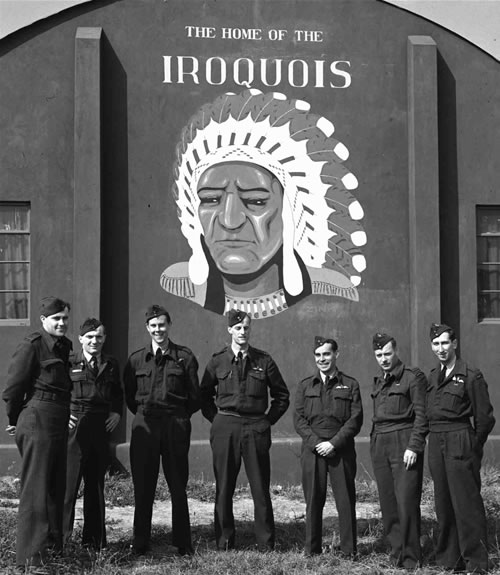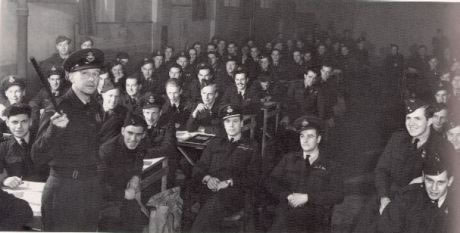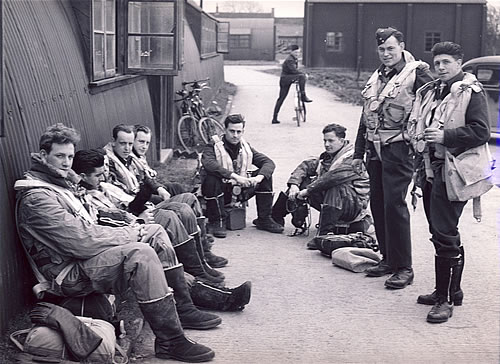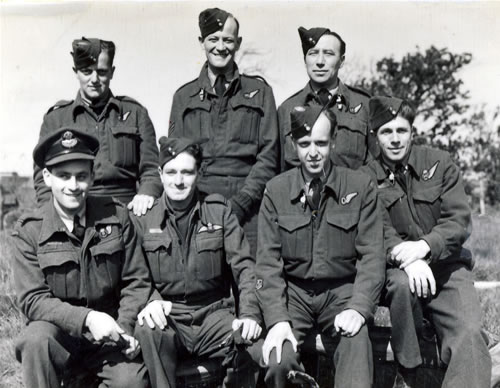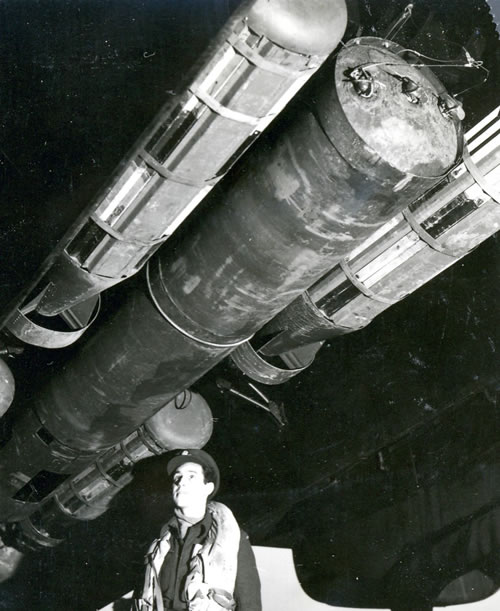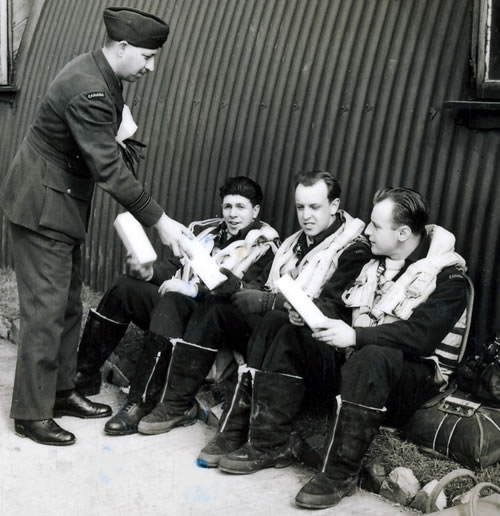Kenneth Tooley Schubert - The Second World War
Operations in England
Our big day arrived – we graduated from the conversion unit as a crew ready for combat. We were posted to the Iroquois 431 Squadron located at Croft, Yorkshire, on March 20, 1944, and made our first training flight from there on April 1st – April Fools Day. The 431 was known as a jinx squadron – their losses were the heaviest in Six Group. They could loose aircraft on training trips. To help overcome the jinx, all the crews posted to the squadron had to be above average. We soon learned that this procedure wasn’t having much effect.
We were scheduled to fly brand new Halifax Mark III’s. This was a far superior aircraft to the Mark II we had been flying. Modifications had been made by changing to more powerful radial engines and changing the tail assembly to correct the stalls. Two crews were assigned to each aircraft, flying alternate nights (all of our operations were at night). We figured we would have this aircraft a long time but, after about three weeks, the other crew “bought the farm,” as the saying goes, and our aircraft never came back. We, in our ignorance, had wondered why the squadron had so many new aircraft.
Croft Aerodrome was new. The only black-top was the runways and dispersal or parking areas for the aircraft. All the rest was mud due to the continual rain. The crews lived in tin Nissan huts that were heated by small coke stoves. We were rationed to one pail of coke a day. We had to improve the ration by raiding the mess’s coke supply. The previous residents in our hut had liberated everything that could be removed for firewood. To light the stubborn coke fire, we used cartridge shells from Very flare guns. We split them open, poured a good portion of the powder under the coke, then we laid a trail of powder a good distance from the stove. One day, the charge was a little heavier than usual and she really lit with a bang. Airmen walking past the hut came running to see what happened. They claimed that the hut had jumped about four inches off the cement slab (so they said). Another time, I burned my arm quite badly on the side of the stove. We knew that if I reported to the medics, I would be removed from active duty and then reassigned to another crew following treatment. To avoid this, we successfully covered up the injury while it healed.
Finally, we were assigned to a diversionary trip similar to the trip to Rennes. This time, we had to fly to a spot in the North Sea 6° east, about half way to Norway. This was to draw the German fighters north, away from a larger bomber raid that was heading south. We never saw anything except whitecaps and were back home before the Germans got wise.
On April 15th, we were scheduled for our first real operational flight over enemy territory. We were to go to Noisy Le Sec, one of the rail yards in Paris. Our load consisted of six 1,000 lb and nine 500 lb high explosive bombs. Some of the bombs had long fuses to delay the explosion up to 48 hours to discourage the Germans from clearing the damage up too quickly.
After the preflight briefing, the crews would head for the aircraft and wait for clearance for the raid. Sometimes, we would wait for hours, only to have the raid cancelled due to poor weather at the target – these waiting periods were hard on the nerves.
If the raid was on, the aircraft taxied out to the runway like a lot of elephants, nose to tail. The first aircraft would start down the runway and wouldn’t be airborne before the next one was on its way. If there was an accident, the kites just kept on taking off over top of the wreckage. Quite often, visibility would be very bad in fog or rain but usually, once airborne, it wasn’t long before you would break through into clear sky. The clouds looked like white rolling hills below with the moon reflecting off of them.
Usually, there was never another aircraft to be seen by the time we reached the English coast but, as we neared the target area, aircraft would be converging from all sides as well as from above and below. We never flew in formation. Each aircraft was supposed to be on the same track and airspeed. Due to human error, enemy action and mechanical problems, however, we were usually spread over a good bit of the sky. When we started our bombing run at Noisy Le Sec, another Halifax had just started their run in front of us. I guess they thought we were attacking them because they opened up on us with all eight guns. They had the air full of tracer bullets all around us, but somehow they never hit us. Anyway, they broke off their bombing run and it was over so fast that we continued on and dropped our bombs on target. We bombed at 6,000 feet and, with the ground lit up from flares and gun flashes, it was easy to see the bomb strikes and the rails and train cars shooting up into the air. We returned to base without damage and a little wiser from the experience.
About March 18th, I received word from Helen that we had a son, Kenneth Charles. This was great news, but was marred by the fact that he had a growth on the base of his spine and was to be operated on as soon as possible. It seemed the operation had to be done and would either be successful or he would not survive. I had no further word on how things were going until I returned from Belgium in September. I then learned that the growth was Spina Bifida and that its roots were intertwined with the spinal cord. The operation had been a success, but left a few problems with cut nerves that they thought were correctable.
We continued to fly operations approximately every other night except when the weather closed in. On April 22, we made our first trip into a German target at Dusseldorf.
The Ruhr Valley was known as flack alley and, after the Dusseldorf trip, we didn’t know why. After takeoff, we managed to miss a wind correction from base. We got far south of the track going into France and, by the time the navigator got our course corrected, we were about ten minutes behind the last wave of the 2,000 bombers that were attacking the target. This was a major sin in Bomber Command. We should have been within ten miles of the major stream of bombers, each flying independently in the dark until they reached the target area. When we were almost 100 miles from the target we could see the fires and, as we got closer, the smoke was over our 23,000 foot ceiling. We could see our target through the smoke – all of the search lights were fixed in cones and there wasn’t another aircraft in the air. There were no fighters, and there was no flack. I had the bomb bay doors open for what seemed an eternity as the aiming point crept up on the aiming gradual. We bombed right on target, closed the bomb bay doors and stooged (took evasive action) home without a shot being fired at us. That was the end of the peace and quiet. When we got back to base for debriefing and made our report, we sure got a strip torn off for being late on target and still later getting back to base, even if we were in one piece. We would never see the Ruhr Valley so peaceful again.
On the 24th of April, we visited Karlsruhe in southern Germany. This was our most spectacular trip. We travelled along with a weather front that was supposed to be behind us, flying just in the clouds. The aircraft was all charged with static electricity, with St. Elmo’s fire running around the window frames and jumping from one gun to another. We were still in clouds when we reached the target and had to bomb on target marker flares dropped by the Pathfinder Force. They dropped the flares on top of the clouds and, if we aimed our bombs at the flares, they would carry on down and be on target below the clouds. The Pathfinder Force leader flew around the target at less than 1,000 feet and would direct the raid by radio. On this target, we were to continue on course for ten minutes and then make two alterations to bring us onto a course for base which should have been clear of the target. Unfortunately, the frontal winds had shifted and, when we were on the homeward course, it took us bang centre over the target that by now was in the clear weather behind the front. There were aircraft going in every direction above and below us, both our own bombers as well as German fighters. Before we got clear of the mess, two ME 110’s (German fighters) had homed in on us and continued to attack in turn from each rear quarter for over half an hour. The rear and upper gunners were kept busy calling evasive actions and the pilot was able to keep us clear of the cannon fire. With all the evasive action, our dead reckoning navigation was shot, so we didn’t know where we were for sure. We knew where Sweden was and we had a good idea where the North Sea was. The navigator came up with a course that should have taken us over Holland and we figured that, if we could reach the North Sea, we would be able to ditch if we ran out of fuel. When we finally crossed the Dutch coast, we got a good fix and were able to get a course for our base at Croft. We got down on the runway after seven and a quarter hours, our longest flight, with practically no fuel left. The next morning, we found that two 4 lb incendiary bombs had punctured our gas tank and were still in the tank. They had been dropped by an aircraft flying above us, no doubt a Lancaster because they had a higher ceiling than the Halifax.
On April 26th, we went back to the Ruhr Valley to deliver seven 500 lb cases of 4-lb incendiaries and eight 500 lb cases of 30-lb incendiaries in an attempt to destroy a ball bearing factory in Essen. We were to attack in waves with over 1,000 other bombers. On this trip, we learned all about flack alley. It was just like a big, black cloud that we had to fly through, with the shrapnel hitting the aircraft like someone continuously throwing small pebbles at us. We got through to the target without any serious problem, although we could see the fires from over 100 miles away. The search lights had the place lit up brighter than day. We could see all of the bombers heading into the target, and right along with them were the German fighters. We could see our bombers going down in flames. The Halifax could only get up to 23,000 feet with a full load. The smoke was thick at that height, and bombs dropped by the Lancasters at 25,000 feet were whistling past us on all sides. It seemed impossible that anyone could fly through this mess and not be hit by something. We ran into the target and bombed and found we had a locked up bomb, so the pilot put us into a steep dive and pulled out into a stall to break the bomb loose. We then closed the bomb bay doors and headed for home much lower than we should have been. As we stooged along, another aircraft appeared above and ahead of us – it turned out to be a JU-88 (German fighter). We flew along in this formation for several minutes and the JU-88 gradually drifted away into the darkness. We got back to base on schedule and without a scratch.
- Date modified:
